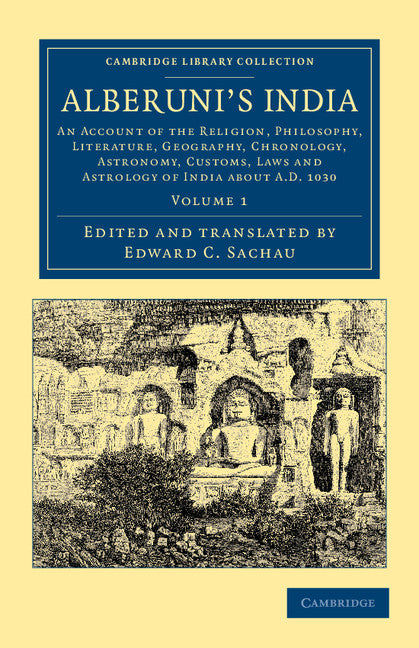Freshly Printed - allow 10 days lead
Couldn't load pickup availability
Alberuni's India
An Account of the Religion, Philosophy, Literature, Geography, Chronology, Astronomy, Customs, Laws and Astrology of India about AD 1030
A two-volume annotated translation published in 1888 of the work on early medieval Indian life by Muslim polymath Alberuni.
Muh?ammad ibn Ah?mad B?r?n? (Author), Edward C. Sachau (Edited and translated by)
9781108047197, Cambridge University Press
Paperback / softback, published 24 May 2012
466 pages
21.6 x 14 x 2.6 cm, 0.59 kg
Translated and annotated by orientalist Edward Sachau (1845–1930), this 1887–8 two-volume work is the account by Muslim polymath and traveller Alberuni (973–1048) of Indian political and social life in the medieval period. Sachau published the manuscript in Arabic in 1885–6, at the same time working on an English translation. Alberuni, born in Chorasmia, south of the Aral Sea, was one of the leading scholars of his day. He accompanied the Afghan ruler Mahmud on his invasion of India in the early eleventh century, and remained there for thirteen years, making a detailed study of Indian life and culture, and in particular studying the Hindu religion. Alberuni claims that his work is not polemical in nature, but a simple historical record of facts, and he commends the learning of the Hindus in philosophy, mathematics and astronomy. Volume 1 discusses Hindu beliefs, the caste system and the calendar.
Editor's preface
Preface
1. On the Hindus in general, as an introduction to our account of them
2. On the belief of the Hindus in God
3. On the Hindu belief as to created things, both 'intelligibilia' and 'sensibilia'
4. From what cause action originates, and how the soul is connected with matter
5. On the state of the souls, and their migrations through the world in the metempsychosis
6. On the different worlds, and on the places of retribution in paradise and hell
7. On the nature of liberation from the world, and on the path leading thereto
8. On the different classes of created beings, and on their names
9. On the castes, called 'colours' (varna), and on the classes below them
10. On the source of their religious and civil law, on prophets, and on the question whether single laws can be abrogated or not
11. About the beginning of idol-worship, and a description of the individual idols
12. On the Veda, the Pur?nas, and other kinds of their national literature
13. Their grammatical and metrical literature
14. Hindu literature in the other sciences - astronomy, astrology, etc.
15. Notes on Hindu metrology, intended to facilitate the understanding of all kinds of measurements which occur in this book
16. Notes on the writing of the Hindus, on their arithmetic and related subjects, and on certain strange manners and customs of theirs
17. On Hindu sciences which prey on the ignorance of people
18. Various notes on their country, their rivers, and their ocean - itineraries of the distances between their several kingdoms, and between the boundaries of their country
19. On the names of the planets, the signs of the zodiac, the lunar stations, and related subjects
20. On the Brahmânda
21. Description on earth and heaven according to the religious views of the Hindus, based upon their traditional literature
22. Traditions relating to the Pole
23. On Mount Meru according to the belief of the authors of the Purânas and of others
24. Traditions of the Purânas regarding each of the seven Dvîpas
25. On the rivers of India, their sources and courses
26. On the shape of heaven and earth according to the Hindu astronomers
27. On the first two motions of the universe (that from east to west according to ancient astronomers, and the precession of the equinoxes) both according to the Hindu astronomers and the authors of the Purânas
28. On the definition of the directions
29. Definition of the inhabitable earth according to the Hindus
30. On Lankâ, or the cupola of the earth
31. On that difference of various places which we call the difference of longitude
32. On the notions of duration and time in general, and on the creation of the world and its destruction
33. On the various kinds of the day or nychthemeron, and on day and night in particular
34. On the division of the nychthemeron into minor particles of time
35. On the different kinds of months and years
36. On the four measures of time called mâna
37. On the parts of the month and the year
38. On the various measures of time composed of days, the life of Brahman included
39. On measures of time which are larger than the life of Brahman
40. On the samdhi, the interval between two periods of time, forming the connecting link between them
41. Definition of the terms 'kalpa' and 'caturyuga', and an explication of the one by the other
42. On the division of the caturyuga into yugas, and the different opinions regarding the latter
43. A description of the four yugas, and of all that is expected to take place at the end of the fourth yuga
44. On the manvantaras
45. On the constellation of the Great Bear
46. On Nârâyana, his appearance at different times, and his names
47. On Vâsudeva and the wars of the Bhârata
48. An explanation of the measure of an akshauhinî.
Subject Areas: Asian history [HBJF]


